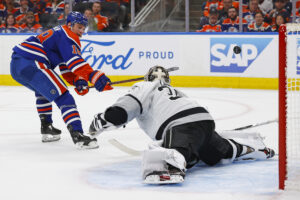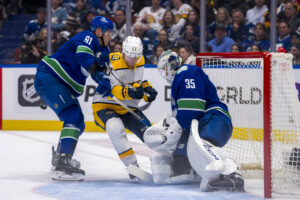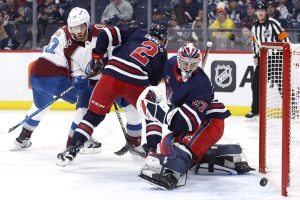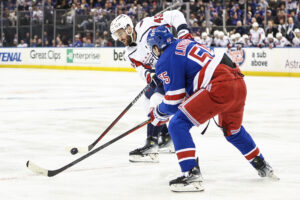Player development seems to always result in more questions than answers. How likely is it for a top pick to pan out? What makes a player a “steal”? Last Word On Hockey will be starting a new series on how to properly develop prospects from all different spots throughout the draft. This week’s piece involves top-10 picks and how they were used early in their careers.
Player Developments of Top 10 Picks
In the span of 2005 through 2015, there were 40 total selections made between fourth overall and tenth overall on forwards playing in North America. Of those 40 selections, four players were given immediate NHL roles, despite being well-behind close to NHL-ready. (For those not sure what those categories entail, check out my previous articles on top-three picks). The four players were Alexander Burmistrov, Jeff Skinner, Josh Bailey and Evander Kane. In this piece, we will be looking at Burmistrov and Skinner, in particular.
Player Development of Alex Burmistrov
Alex Burmistrov was the eighth overall selection of the Atlanta Thrashers back in 2010. He played just one season, his draft-year, in North America, after having played at the MHL level in Russia. In his DY-1 season in the MHL, Burmistrov recorded 28 goals and 30 assists for 58 points in 41 games, or 1.415 points per game. That was good enough for second among the 40 North American forwards selected between fourth and tenth overall in the aforementioned time frame for DY-1 production. Remember, he played in the MHL in order to get those stats, which is arguably weaker than a majority of North American leagues.
As for his DY production, Burmistrov played with the OHL’s Barrie Colts. He posted 22 goals and 43 assists for 65 points in 62 games, setting a pace of 1.048 points per game. That pace ranked 31st among those same 40 players for DY production. Despite a seemingly rough transition to the smaller North American rinks, the Thrashers would bring Burmistrov directly into the first-team fold.
How was Burmistrov used?
Burmistrov would play 74 NHL games in his rookie year, recording six goals and 14 assists for 20 points. He did this while averaging 13:13 time on ice per game. As for his analytics, Burmistrov did not have a great year. He had an EVO* of -0.3 and an EVD* of -1.5, ranking him below replacement value at even-strength. Overall, his WAR was -0.1 and his GAR was -0.7, which suggests that he was a negative impact player as a rookie.
However, despite a rough rookie campaign, the Thrashers, who became the Winnipeg Jets in his second season, would actually give him a considerable raise in ice time. He would play 76 games in his sophomore season, recording 13 goals and 15 assists for 28 points, averaging 16:40 ice time per game. Analytically, he improved greatly. His EVO jumped up to 2.5, his EVD rose to 1.2, his WAR got bumped up to 1.1 and his GAR also improved to 6.5. The Jets threw Burmistrov’s training wheels in the trash and pushed him right onto the open road. He had not proven, even in a sheltered role, that he was ready, but he kept himself upright and succeeded. It was a very promising performance as he was heading into the last year of his entry-level contract.
The Impact of the Lock-Out
Burmistrov’s third NHL was hampered by labour agreements which lead to the 2012-13 season being shortened by a lockout. He would play 44 NHL games and 22 AHL games that year. At the AHL level, he recorded two goals and nine assists for 11 points in those contests, while recording four goals and six assists for 10 points in the NHL. Burmistrov saw 15:38 average time on ice per game at the NHL level that season, similar to his role the previous year, but struggled once again analytically. His EVO and EVD dropped to the negatives, at -0.5 and -0.2, respectively. His WAR and GAR dropped as well but stayed positive at scores of 0.1 and 0.3.
After that third NHL season, when his entry-level deal expired, Burmistrov would return to Russia for two seasons. Playing for Ak Bars Kazan, he would score a combined 20 goals and 44 assists for 64 points in 107 KHL contests. He later returned to the NHL between 2015-2018 before leaving once again for the KHL.
Player Development of Jeff Skinner
Jeff Skinner, drafted seventh overall by the Carolina Hurricanes in the 2010 NHL draft. Out of the OHL’s Kitchener Rangers, Skinner would produce 27 goals and 24 assists for 51 points in 63 games in his DY-1 season. That total was good for 0.81 points per game, ranking 26th out of those 40 forwards in DY-1 production. In his DY, Skinner would play 64 games with 50 goals and 40 assists for 90 points. That was good for 1.406 points per game, ranking 15th among those 40 forwards in DY performance. Based on those outputs, he was deemed not NHL ready, but that didn’t stop Carolina from giving him an immediate NHL role.
How was Skinner used?
Skinner may not have been NHL-ready, but you would never have known it given how his rookie season went. He scored 31 goals and 32 assists for 63 points in a full 82-game season. Skinner went on to win the Calder Trophy for his excellent performance, all while averaging 16:44 TOI. Analytically, he was outstanding. Skinner produced a 10.7 EVO and a -2.4 EVD. That rookie year EVO score beat the likes of Connor McDavid and Patrick Kane in their respective rookie seasons. As for WAR and GAR, Skinner recorded scores of 2.8 and 15.8, respectively. Those tallies, once again, beat McDavid and Kane in their rookie years.
After an incredible first season, Skinner would follow that up with a slight sophomore slump. In 2011-12, he played 64 games, averaging 18:37 time on ice per game, scoring 20 goals and 24 assists for 44 points. His production certainly wasn’t bad, but his analytics painted a larger decline. His EVO and EVD both dropped to 7.7 and -2.6, respectively, while his WAR and GAR also dropped to 1.7 and 9.8.
More Decline In Year Three
Despite a down season after getting a raise in ice time and taking on tougher match-ups, Carolina held faith in their top draft pick by playing him an average of 18:28 time on ice per game in his 42 games played. His third season, 2012-13, was the lock-out shortened year, and it clearly had an impact on Skinner. He would produce 13 goals and 11 assists for 24 points, a clear step down from the prior seasons, and would watch as his analytics took a nosedive. Skinner’s EVO plummeted down to a 0.2 score and his EVD score got worse, dropping to a -3.9. His WAR (0.4) and GAR (2.4) remained above replacement-level but still saw a sharp decline.
Post ELC, Skinner remained with the Hurricanes and played five more seasons in Carolina, scoring 140 goals and 108 assists for 248 points in 391 games. In his last three seasons, Skinner has played for the Buffalo Sabres, with his first season in Buffalo being a career year. However, his last two seasons are ones to forget.
Where Are They Now?
Alex Burmistrov is currently playing in the KHL with Ak Bars Kazan. His development with the Thrashers/Jets organization did not go as planned. For one, Burmistrov had played in Russia all the way up until his draft season, where he would struggle to produce at the same rate as other top-10 picks playing in North America. He needed another season to acclimate to the North American rinks, but instead, they tried to bring him through the Evander Kane path. They played him for just under 14 minutes as a rookie, saw him struggle, then gave him a raise in ice time.
Unlike Kane, he never improved from his rookie year into his second season, and the lock-out-shortened third year prevented him from trying to right the ship. Burmistrov would return to Russia for a few seasons. Then, he’d receive a few NHL stints later in his career that were not successful. Finally, he wound back up in Russia once again, seemingly for good. The player development of Burmistrov was simply not good enough by the Jets.
Jeff Skinner’s Player Development
Skinner is an interesting case study. He would go on to record one of the best rookie campaigns in the 2005-2015 time frame. However, he would never surpass his rookie year stat of 63 points or 32 assists. While his production was never bad until recently, he would really only ever develop into a second-line winger or center that would struggle defensively. Skinner currently plays for the Buffalo Sabres, where he has had two horrendous seasons, partially due to poor deployment.
Overall, the player development of Skinner went extremely well to start. Unfortunately, the player never took another step forward.






